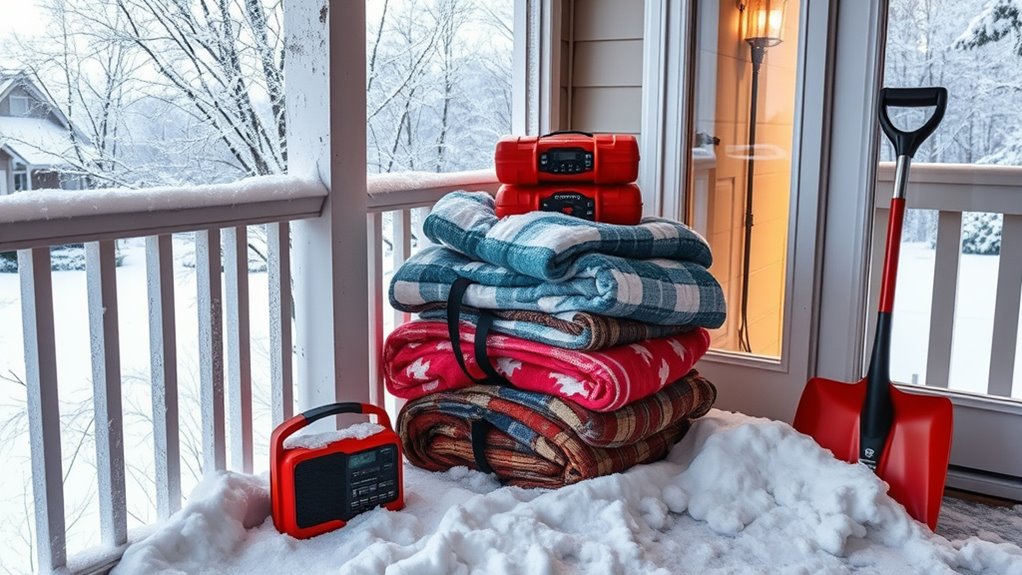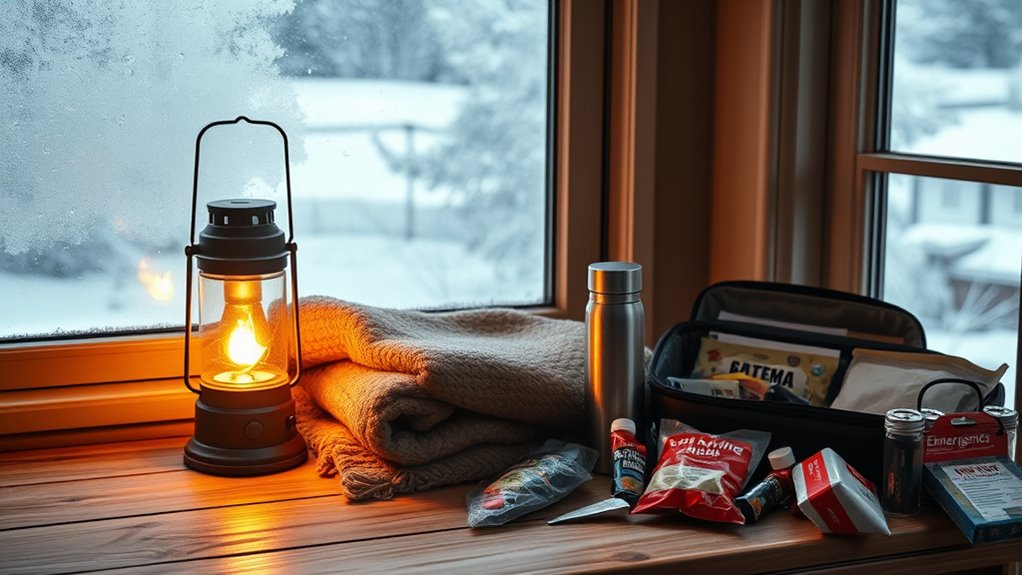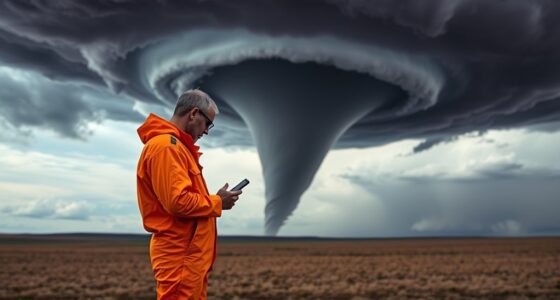To prepare for a winter storm, stock essentials like warm clothing, non-perishable food, bottled water, and emergency tools such as flashlights and batteries. During the storm, stay indoors, dress in layers, and avoid overexertion if shoveling snow. Make sure your home is well-insulated, seal drafts, and have a plan for power outages. Afterward, check for damage and keep emergency contacts handy. Continuing with these tips will help you stay safe and ready.
Key Takeaways
- Stock essential supplies like warm clothing, non-perishable food, water, and batteries before a storm.
- Prepare your home by sealing drafts, adding insulation, and maintaining heating systems.
- During the storm, stay indoors, use flashlights, and limit opening the fridge to preserve food.
- Dress in layers, cover extremities, and avoid overexertion when shoveling snow or clearing ice.
- After the storm, assess damage safely, document for insurance, and clear debris from walkways.
Essential Supplies to Stock Before a Winter Storm

Before a winter storm hits, it’s crucial to stock up on essential supplies to guarantee you stay safe and comfortable. Start with winter clothing—layered, waterproof jackets, hats, gloves, and thermal underwear will keep you warm during power outages or if you need to venture outside. Proper winter clothing prevents hypothermia and frostbite. Also, focus on food storage; keep enough non-perishable food like canned goods, dried fruits, and energy bars to last several days. Don’t forget bottled water and other beverages to stay hydrated. Having a well-stocked supply ensures you won’t need to leave home unnecessarily. Prepare a dedicated area for your supplies, making it easy to access everything quickly. Staying prepared with the right clothing and food storage is your first line of defense against winter storms. Using reliable emergency preparedness tools can also help ensure you are ready for any situation.
Safety Tips During a Winter Storm

During a winter storm, staying safe means actively managing the risks posed by freezing temperatures, snow, and ice. If a power outage occurs, use flashlights instead of candles to prevent fires, and keep spare batteries handy. Dress warmly in layers, covering extremities to prevent frostbite. Stay indoors as much as possible, and avoid overexertion when shoveling snow. Keep emergency contacts—such as local authorities, utility companies, and healthcare providers—easy to access in case you need assistance. If you lose power, limit opening the fridge and freezer to preserve food. Stay informed through battery-powered radios or mobile updates. Remember, staying calm and prepared helps you respond effectively to winter storms and minimizes risks during these hazardous conditions. Ensuring your home heating system is functioning properly can also prevent dangerous cold exposure inside your home.
Preparing Your Home for Severe Cold and Snow

Preparing your home for severe cold and snow starts with sealing any drafts around windows and doors to keep the warmth inside. Proper insulation techniques, such as adding weatherstripping or door sweeps, help retain heat and reduce energy costs. Fireproofing measures, like clearing combustibles away from heating sources and installing smoke detectors, enhance safety during winter storms. Consider upgrading insulation in attics, basements, and walls to improve overall efficiency. Below is a table illustrating key actions:
| Action | Purpose |
|---|---|
| Seal drafts around windows and doors | Prevent heat loss and cold air infiltration |
| Add insulation in attic | Keep warm air from escaping through the roof |
| Install smoke detectors | Ensure early fire detection and safety |
| Clear combustibles near heaters | Reduce fire risk during heating use |
| Maintain heating systems | Keep systems functioning efficiently and safely |
Taking these steps helps protect your home and loved ones from winter’s worst.
After the Storm: Cleanup and Recovery Steps

Once the storm subsides, it’s time to focus on cleanup and recovery. Begin with a thorough damage assessment of your property, checking for fallen trees, broken branches, or structural issues. Document all damage with photos and notes, which will help when filing insurance claims. Safety is paramount—wear protective gear, watch for downed power lines, and avoid unstable structures. Clear debris from walkways and driveways to prevent accidents. Contact your insurance company promptly to report damages and start the claims process. If you spot extensive damage, consider hiring professionals for repairs and inspections. Remember, timely action guarantees your home is safe and helps you recover more efficiently from the storm’s impact. Additionally, understanding local resources and tools can expedite access to assistance and support during recovery.
Frequently Asked Questions
How Can I Prevent Pipes From Freezing During a Winter Storm?
To prevent your pipes from freezing during a winter storm, insulate them with pipe insulation, especially in unheated areas. Keep a slow faucet drip running to relieve pressure and prevent bursts. Additionally, open cabinet doors beneath sinks to allow warm air to circulate around pipes. You should also seal any leaks around windows and doors to maintain indoor warmth. Taking these steps helps keep your pipes safe from freezing temperatures.
What Are the Signs of Carbon Monoxide Poisoning in Winter?
You might notice dizziness, headache, or nausea, which are common carbon monoxide symptoms during winter. Sometimes, these winter poisoning signs appear suddenly, especially if your heating system is faulty. If you feel fatigued or confused, it could be a sign of carbon monoxide poisoning. Be alert to these symptoms, and verify your detectors are working properly to prevent dangerous buildup of this colorless, odorless gas.
How Do I Keep My Pets Safe During Severe Cold?
To keep your pets safe during severe cold, make certain they have proper pet winter safety gear like jackets and paw protectors. Bring them indoors during extreme weather and provide pet warm shelters if they stay outside. Regularly check their water to prevent freezing and watch for signs of cold stress. By prioritizing pet winter safety, you protect your furry friends from frostbite and hypothermia, keeping them comfortable and safe.
What Should I Do if Power Outages Last Multiple Days?
Imagine being stranded in a storm, like a lone sailor lost at sea. If power outages last days, stay safe by using your emergency kit with essentials like blankets, batteries, and non-perishable food. Seek shelter options such as community centers or heated public spaces if your home isn’t safe. Keep a battery-powered radio handy to stay informed, and check on neighbors who might need help during extended outages.
Are There Specific Clothing Recommendations for Extreme Cold?
When facing extreme cold, you should wear thermal gear and layered clothing to stay warm. Start with moisture-wicking base layers to keep sweat away from your skin. Add insulating layers like fleece or down, and top it with a waterproof outer layer to protect against wind and snow. This combination traps heat effectively, ensuring you stay warm and dry in harsh winter conditions. Always prioritize proper clothing to prevent frostbite and hypothermia.
Conclusion
By stocking essential supplies, staying safe during the storm, preparing your home, and recovering afterward, you guarantee you’re ready for whatever winter throws your way. Be proactive, be cautious, and stay informed. Keep your family warm, your home secure, and your mind focused. Prepare today, protect tomorrow, and face the winter storm with confidence. With these steps, you’ll turn winter’s challenges into moments of resilience and readiness.









